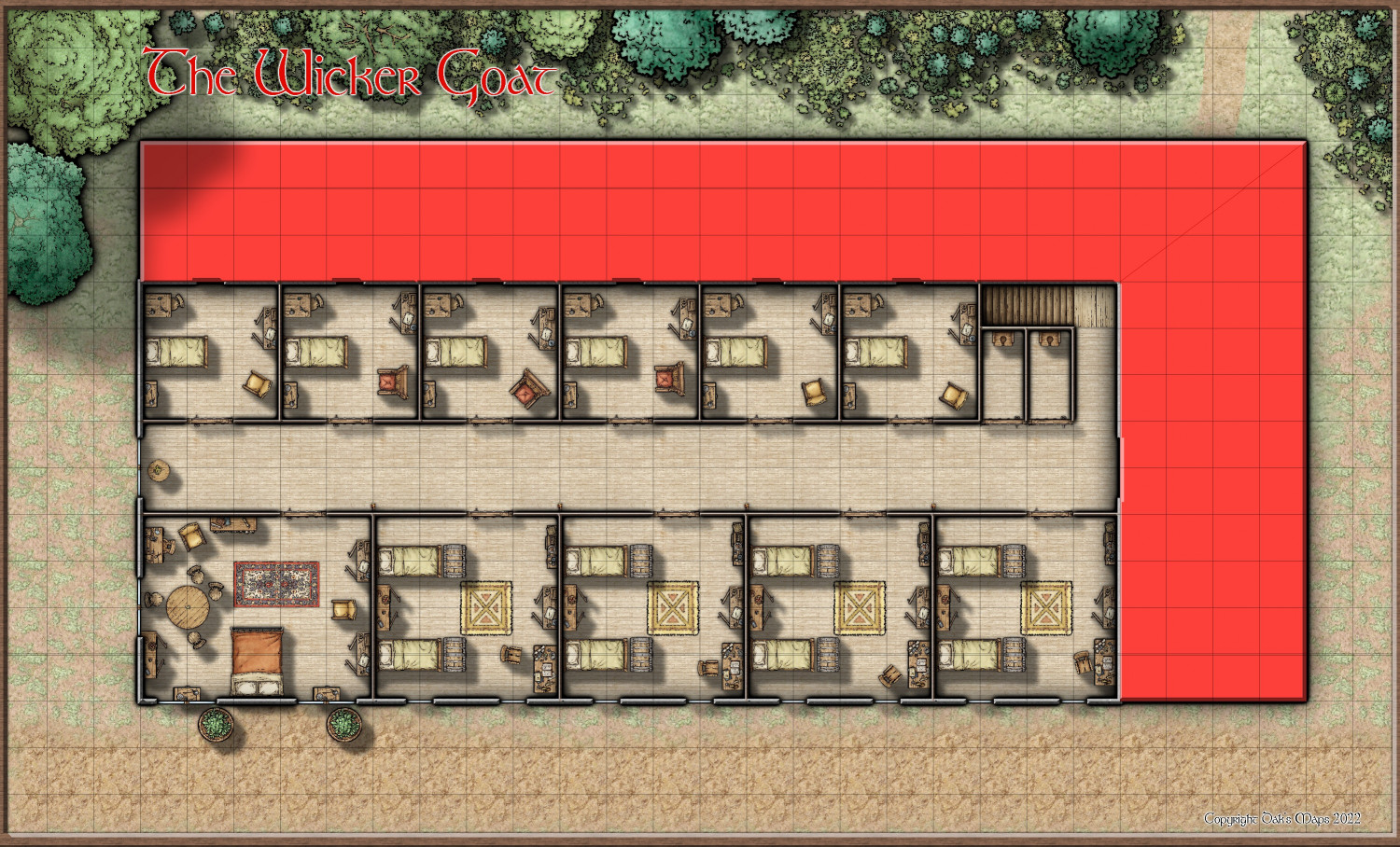WIP tavern
 Dak
🖼️ 37 images Surveyor
Dak
🖼️ 37 images Surveyor
Hi everybody, this is a WIP for a tavern in the Saltmarsh game. It's the upper floor of a tavern and I wanted to have some of the roof of the floor below on it.
Basically I wanted to put a tile effect on the roof, but I'm not sure how best to do this. Can anybody advise me or send me to a vid where this is demonstrated?





Comments
Probably best to use one of the roof tile fills from one of the city styles?
Thanks for the reply, but I have no idea how to get a city fill into dungeon designer. When I try I just get ugly versions of block colour that look worse then the red fill on the map above.
Is there a vid somewhere of someone showing how you do this?
Check this FAQ entry. It contains a pair of video links in addition to the text.
Thanks so much for that Monsen. I will try it out soon, but today I seem to be having problems with my system which has shut down CC3+ twice now without warning.
When (if) I manage to do the roof I will post the results here.
Thanks again though.
Hi Monsen,
Thanks for the info. Unfortunately, I have been through all the styles I have to find a roof tile fill, but I don't have any roofs in those styles.
Can you recommend some styles that have roof tile fills?
Thanks Dak
What add ons do you have, Dak?
Jon Roberts City styles comes with CC3 these days, so you should have these few , even if you don't have anything but CC3
CD3 has quite a few roof fills, and there are more to be found in Cities of Schley and lots of different annual issues that are city styles.
Here are the Cities of Schley roof tile fills
Some of the annual issues are more realistic. It depends what you want, but since you are using SS4 as the map you will probably find that SS5 (immediately above) is a better match.
Sorry about the red lines crossing everything out. These aren't big enough to be much use to anyone, but you never know!
Thanks so much for this Sue. I see where I was going wrong now and have followed Monsen's advice in the vid, and your help here to produce this. There may be better matches, but I used the SS5 style as this does what I want and is very close to the vision for the roof that I had.
Thanks again.
You're welcome :)
While the size may seem wrong, by a strict comparison with some medieval European structures, this isn't for medieval Europe, it's for fantasy D&D, and is close to the scale size for this specific tavern as shown on Mike Schley's map of Saltmarsh in the Ghosts of Saltmarsh scenario book (Wizards of the Coast, 2019), assuming five-foot grid squares here. The appearance isn't quite the same as on that map, but this is an adaptation after all, and although there are a number of designs for the Wicker Goat Tavern online, I don't think there's an official D&D version, so some leeway is to be expected.
In the original adventure (The Sinister Secret of Saltmarsh, TSR's Module U1, from 1981), you were expected to create your own version of the town from scratch - there are a few guidelines for key points, such as Point 4: "Decide where the characters could stay when resting in the town between adventures (the best inn? the only inn?); draw up a tariff (list of expenditures) for their accommodation and food." But that's as close as we got to a description for the inn/tavern, which didn't even get a name back then!
That's not to say such points should just be ignored necessarily, and the heating and access points are useful considerations. However, if the final tavern is meant to fit to the size of the official Saltmarsh map, this is close enough to work for that.
Both @Wyvern and @DaltonSpence raises some interesting points about scaling here, and the critique of scaling in a map.
Personally for me, (A)D&D (and several others) have always been about a medieval setting with a twist. The introduction of magic and adventurers change the picture somewhat, but for me, these people have always been a kind of privileged people. Not everyone is a magic user, or even know a magic user. A town may have a town church with a few clerics and a town mage, but these few people doesn't significantly change the town outside their own abode, they have their own things to worry about, and their services are expensive enough that the average peasant/shopkeeper/innkeeper/smith/hunter/etc can't afford their services just to make simple things easier (like building a house that defy the general medieval technology level). Adventurers find treasure and bring in money, but while it may make the adventurers rich, it isn't that much divided over a town, making their contribution minor as well. As such, I've always felt that anything not adhering to medieval standards is "wrong" unless there is very good reason for it (and not all innkeepers can be ex-adventures who retired with both fortune and magic). And thus I've felt that a lot of the buildings from official sources are just plain wrong, either just because they are more focused on working as a battlemap than being a true building floorplan, or because the original designer was just ignorant of the subject matter. It just feels wrong when a common single-bed room at a common inn is larger than many people's living rooms in modern times.
Of course, many people will disagree with me here, one told me years ago that he didn't see anything medieval in D&D at all. Some people think I am horrible boring, and think it is much better when the world is filled to the brim with the fantastical. This is of course a matter of opinion. I find that I have more fun when the fantastical is rare, and the world itself is "as medieval as possible" within a realm that after all do have magic users and dragons. But the fact that I prefer one style doesn't make the other viewpoint less valid. Whether you made the map because that's the way you like it, or because you're trying to stay true to the source material doesn't matter. If you end up with what you were trying to do, then it is a good map.
OK, that turned out to be a longer rant than expected. What I was trying to say is that I find these aspects of critique both interesting and valuable. Not just for the actual mapper, @Dak in this case, but also for others in thinking about how your map should look. Some critique may or may not be invalid for the current mapper, but are still valid points to make in a more general sense.
WOW ! ! !